Features
American Transgender journalist joins Ukrainian military
Ashton-Cirillo entered Ukraine in March with the intention of covering refugees who had fled the country & ended up fighting for its defense
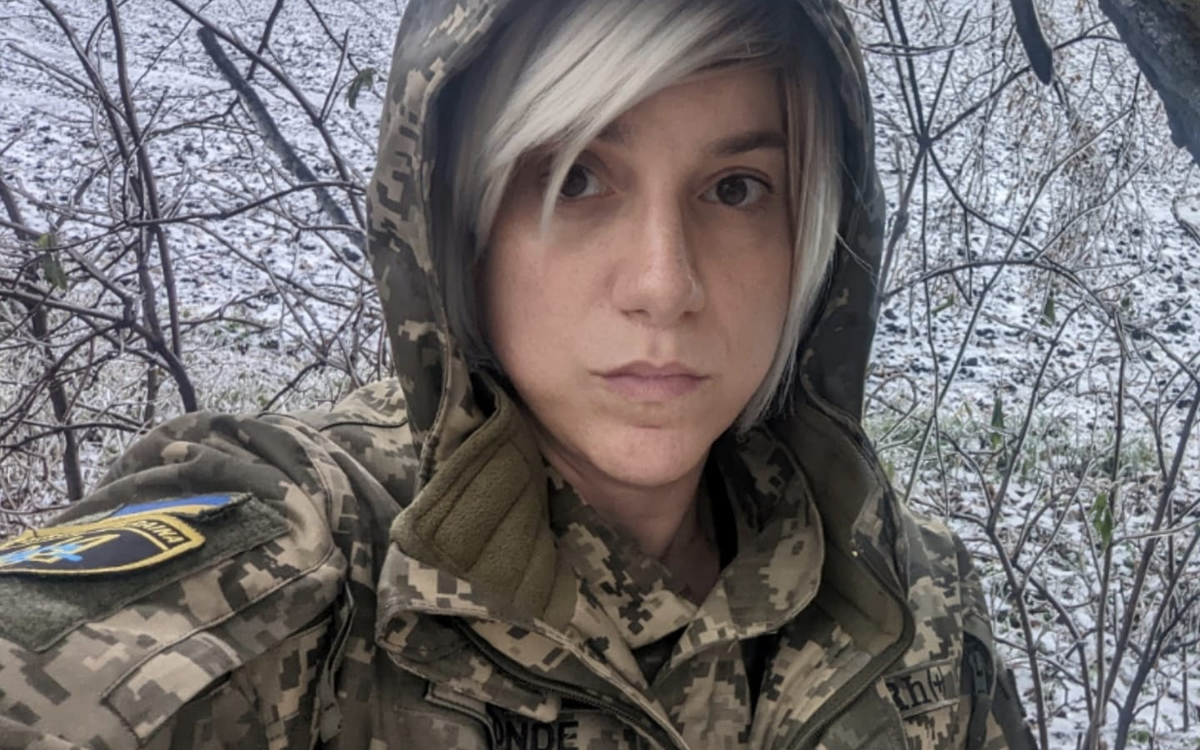
WASHINGTON – It was shortly before 1 p.m. on Dec. 9 when Sarah Ashton-Cirillo, a member of the Armed Forces of Ukraine’s Noman Çelebicihan Battalion, arrived at Le Bon Café, a coffee shop on Second Street, S.E., near the U.S. Capitol.
The Las Vegas native who was wearing her uniform sat down at an outdoor table and began to sip a coffee as she talked about the journey that brought her from the U.S. to the frontlines of Russia’s war against Ukraine.
Ashton-Cirillo in 2015 traveled to eastern Turkey to cover Syrian refugees who had fled their country’s civil war.
She said she was “supposed to have started the story in Syria, but I was too scared.” Ashton-Cirillo later wrote a book, “Along the Tracks of Tears,” but she told the Washington Blade that she “was terribly unhappy with” it.
“Some of it had to do with being trans,” she said. “I had been traveling with Muslims, with different groups, and they were accepting me, but I would always have in the back of my mind, would they have talked to me if they knew I was trans or a female.”
Ashton-Cirillo, who was born in northern Florida, was the director of communications for a California-based health care company before she launched Political.tips, a website that focused on politics in Nevada and across the country. Ashton-Cirillo has also sought to expose extremist Republicans through her reporting.
‘I was not expecting it to happen’
Ashton-Cirillo noted she wrote her second book, “Fair Right Just,” while she was in the Baltic states (Estonia, Latvia and Lithuania.) Ashton-Cirillo told the Blade that she learned about what Russia had done to them through mid-winter visits to museums.
“That led me to hate Russia, because I’m reading about things that ended up being pertinent today: Filtration camps, the language issues, they were trying to erase culture, the genocide, the torture of political prisoners, everything that we’re living now, the folks in the Baltics lived 80 or 90 years ago, as do the Ukrainians, but I hadn’t been to Ukraine yet.”
Russia launched its war against Ukraine on Feb. 24, 2022.
“It always bothered me for 6 1/2 years,” said Ashton-Cirillo, referring to her book about Syrian refugees. “As I was watching this unfold, I said, oh, there’s a massive refugee situation. Is it worth it for me to go over and try to maybe get new material and put out a book that would actually take the old material and the new material and put it together. I put it together, and so when the war actually broke out, I said, holy shit this is real and that’s why I wasn’t here (in Ukraine) on the first day. I was watching it.”
Ashton-Cirillo conceded she is “the first to say I was not expecting it to happen.”
“With the full-scale invasion happening on Feb. 24, even though Donbass had been under siege, and there had been a war going on for or years, I didn’t expect there to be an invasion, a land invasion of a full country, not just in this area that had been, you know, that the Russians had seized when basically the world was sleeping,” she said.
Ashton-Cirillo entered Ukraine on March 4, 2022, with the intention of covering refugees who had fled the country. She said the press credentials the Ukrainian government reflected her gender identity and her legal name.
“My legal name, Sarah Ashton-Cirillo, was my legal name when I traveled. My gender was my legal gender when I traveled due to having changed it in Nevada,” said Ashton-Cirillo. “My driver’s license was changed but my passport had not been changed … it was very complicated because it looked like a totally different person with totally different names, a totally different gender.”
Ashton-Cirillo noted Ukrainian officials put her legal name on the top of her press credentials and “formally known as my previous name” on the bottom of them.
“I was okay with it because I couldn’t believe they credentialed me anyway with the situation being the way it was,” she said.
Jessica Stern, the special U.S. envoy for the promotion of LGBTQ and intersex rights, less than a month after the war began told the Blade that many trans and gender non-conforming Ukrainians decided to remain in the country because they could not exempt themselves from military conscription. Stern during the March 18, 2022, interview cited the case of a trans man who tried to leave Ukraine and “in an effort to prove who he was, who he said he was, he was actually forced to remove his shirt and show his chest” at the border.
“Unfortunately, that’s not the only humiliating and potentially violent incident that I’m hearing,” she said.
One of the stories that Ashton-Cirillo wrote for LGBTQ Nation while in Ukraine highlighted problems that trans people had when they tried to leave the country because their ID documents did not match their gender identity.
Gender Stream, a Ukrainian advocacy group, helped more than 50 trans and nonbinary people obtain the necessary paperwork that allowed them to leave the country. Ashton-Cirillo acknowledged there was “gatekeeping, but people could get out.”
“Nobody knew what to do,” she said, referring to the treatment of trans and nonbinary Ukrainians who wanted to leave the country immediately after the war began. “Every male was mobilized. It was just something I don’t think was ever going to come up in the purview. The other thing not coming up in the purview was getting a trans journalist popping in with an ID that was totally different. I didn’t expect to get let in. I didn’t expect to get credentialed.”
Russian airstrike killed activist days before Ashton-Cirillo arrived in Kharkiv
Ashton-Cirillo told the Blade that she wanted to go to Kyiv, the Ukrainian capital, and cover Russia’s efforts to seize it. Ashton-Cirillo instead traveled to Kharkiv, the country’s second largest city that is less than 30 miles from the Russian border in eastern Ukraine.
Elvira Schemur, a volunteer for Kyiv Pride and Kharkiv Pride, was inside the regional administration building in Kharkiv on March 1, 2022, when a Russian missile struck it. The 21-year-old law student was among those who were killed.
Ashton-Cirillo arrived in Kharkiv eight days after Scheumer’s death.
CNN Chief International Correspondent Clarissa Ward was among the journalists who reported from Kharkiv during the first weeks of the war. Ashton-Cirillo recalled to the Blade a conversation that she had with her shortly after she arrived in the city.
“Clarissa says to me, via the Twitter Space, Sarah, I’ve been following your work in Kharkiv. It’s great,” recalled Ashton-Cirillo. “If you don’t leave you’re going to be traumatized for the rest of your life because this is the worst bombing … she knows it.”
“She’s an idol of mine,” she added. “She’s somebody that I look up to from a journalistic standpoint … I didn’t understand what that meant because I’m embedded with security services and not only am I trans, I’m living with security forces during the bombings as a trans woman and a journalist and I’m living with them. I was seeing things that no one else was seeing, but I was also living in a bubble and because of that I was living this life of war and I was living this life of terrorism and death every single day, but I didn’t realize it.”
Ashton-Cirillo said the only foreigner she saw from the time she arrived in Kharkiv until April 21 was an Al-Jazeera reporter who visited the same site that Russia had attacked.
“I was in a bubble and didn’t realize what I was going through was not normal,” she said. “It was not normal because journalists come in and out, they have each other to talk with. I was totally on my own.”
Ashton-Cirillo lived and worked with local security officials. She also helped them deliver weapons to checkpoints while she was not writing about the war.
The mayor of Zolochiv, a village in Kharkiv Oblast that is 10 miles from the Russian border, named Ashton-Cirillo his official representative in negotiations with foreign aid groups after he met her. She said there “was devastation” in the village when she first arrived.
“I’m on the Russian border and I’m being empowered as power of attorney for this town of Zolochiv. This was my focus in between my writing,” she said. “I would go up there and do my things, but I was not a combatant yet.”
Russian Foreign Ministry spokesperson targets Ashton-Cirillo
Russia’s castration of gay Ukrainian men and hunt lists for LGBTQ and intersex people in Mariupol and other cities are among the stories that Ashton-Cirillo wrote for LGBTQ Nation.
She notes in one LGBTQ Nation article that Russian Foreign Ministry spokesperson Maria Zakharova on April 21 publicly accused her of participating in the disappearance of journalist Gonzalo Lira, who, she noted “was being held by Ukrainian State Security services.” Zakharova, according to Ashton-Cirillo, described her as a “transgender journalist from Las Vegas” who took pictures with “gangsters,” a reference to Ukrainian soldiers.
“It made me cry. It was the first time I cried,” Ashton-Cirillo told the Blade. “It was the worst and then it unleashed right-wing trolls. Glenn Greenwald jumped on it.”
Joe Oltmann, a Denver-based podcast host, falsely accused Ashton-Cirillo of murdering Lira. Ashton-Cirillo has filed a defamation lawsuit against the prominent 2020 election denier.
“All this insanity was going on and I’m crying,” said Ashton-Cirillo.
She said a member of the Azov Regiment, a Ukrainian National Guard unit that defended the port city of Mariupol during the Russian siege, asked her why she was crying.
“You come out to the rocket attacks. You see dead bodies. You don’t cry,” he said.
“Maria Zakharova attacked me,” said Ashton-Cirillo.
“I’m so proud of you because that means you’re really getting to them,” responded the Azov Regiment member.
Ashton-Cirillo told the Blade the conversation “changed my whole mindset.”
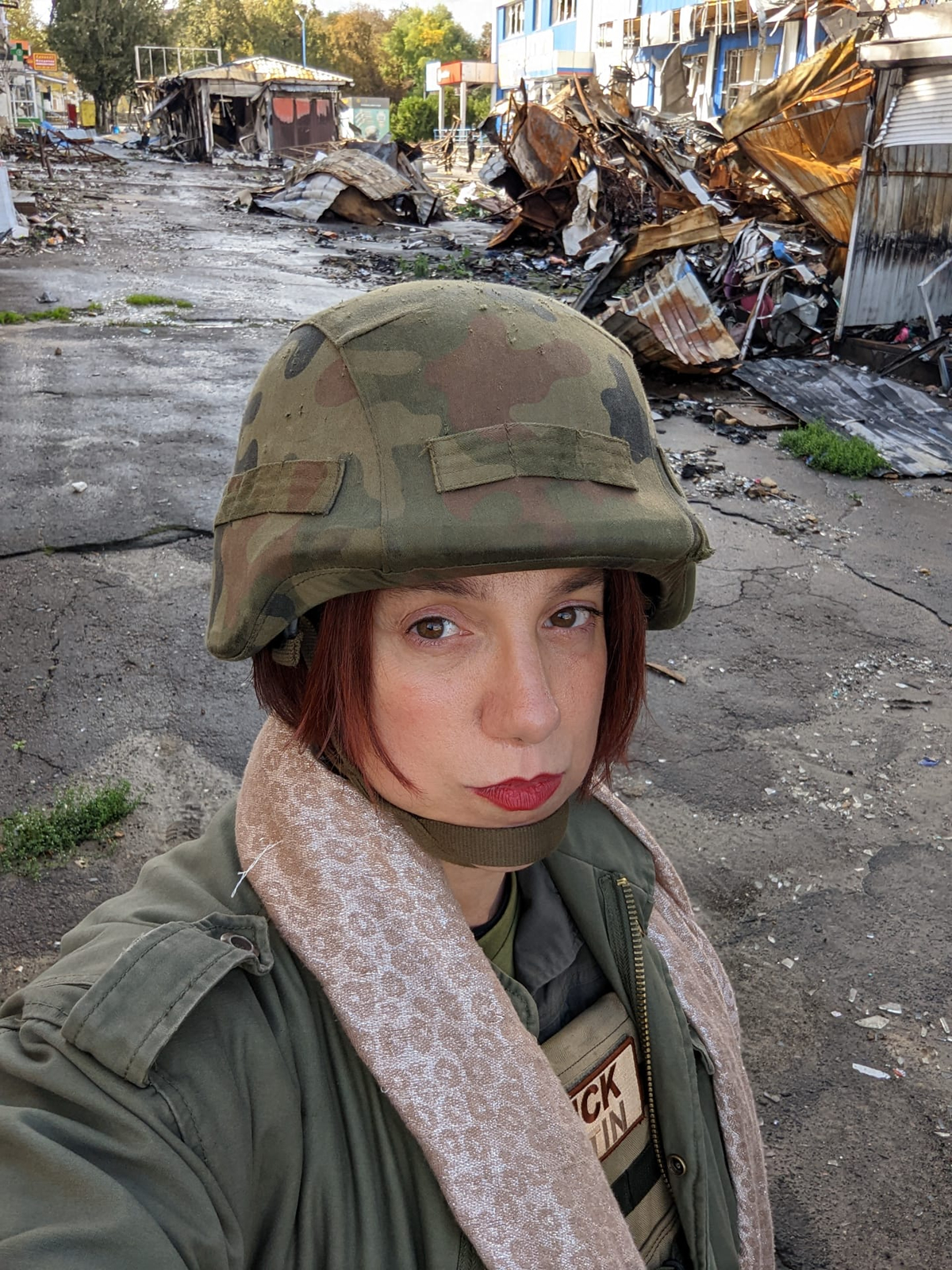
Ashton-Cirillo soon began to work for the Kharkiv Media Hub, which supports journalists who are working in the city. Ashton-Cirillo also continued her work with Zolochiv and NGOs, including José Andrés’ World Central Kitchen, once they reached areas that Ukrainian forces had liberated from Russia.
“I was so proud to see these guys,” she said, referring to World Central Kitchen. “This organization gets it.”
Ashton-Cirillo began to work for the Ukrainian Defense Ministry in a civilian capacity in August. She continued to represent Zolochiv.
“My mind wasn’t on the stories anymore,” said Ashton-Cirillo. “I knew how much work I was doing for the government. I pushed the envelope as far as I could without, I think, getting into an ethical dilemma from a journalistic standpoint because I love journalism.”
Ashton-Cirillo said discussions about her enlisting in the Armed Forces of Ukraine were already taking place when the Kharkiv counteroffensive began in September. Ashton-Cirillo told the Blade that she also worked to counter Russian propaganda that included the claim that Russian troops had captured Bakhmut, a city in Donetsk Oblast.
“I’m in Bakhmut. Fighting is literally all around. I’m standing there grinning at City Hall, look, Russia doesn’t have it. It’s lies,” she recalled. “I get a phone call that night, we’re ready to enlist you.”
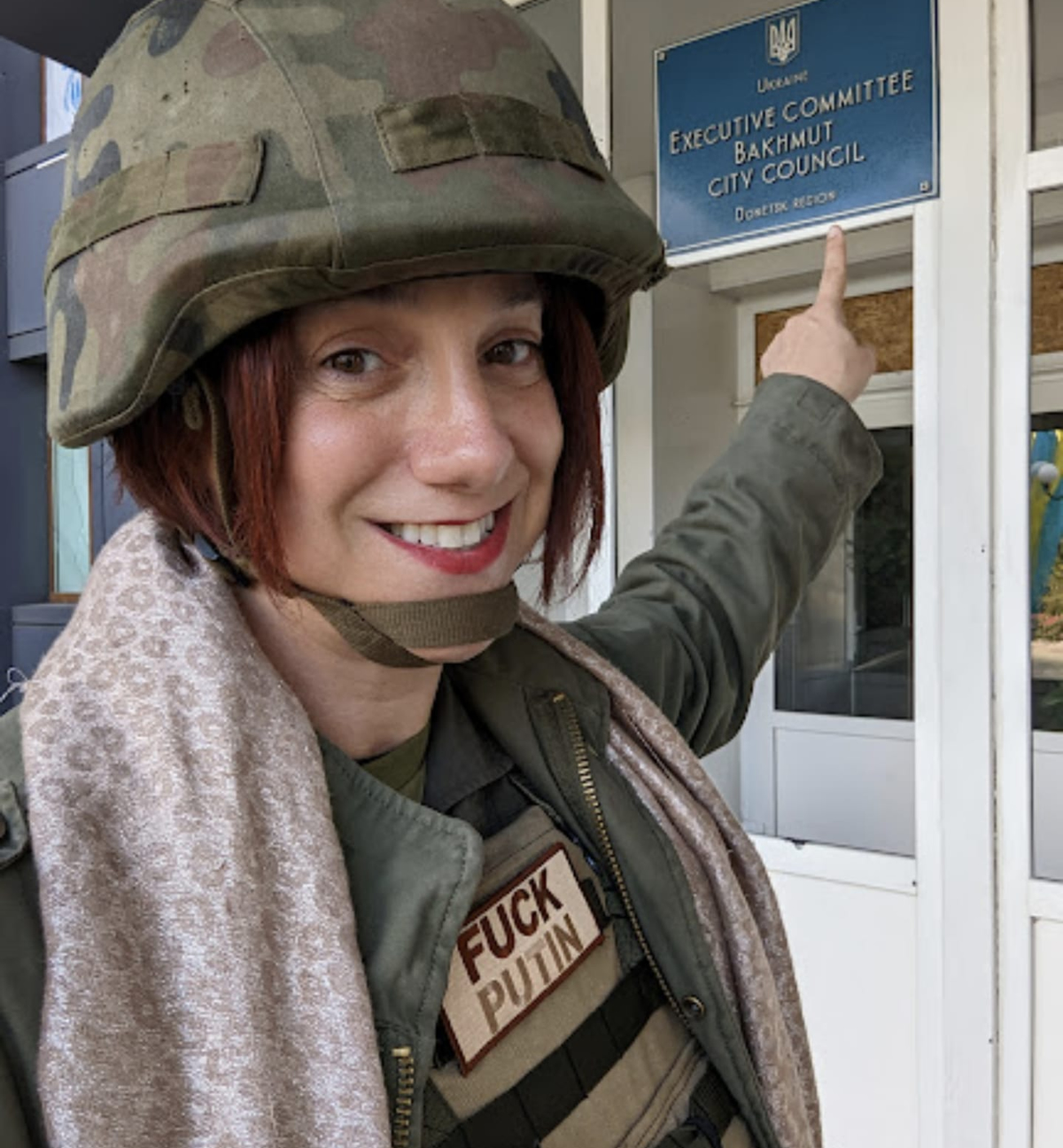
A journalist drove Ashton-Cirillo from Bakhmut to Kyiv.
“I had never been to Kyiv,” she said. “I get to Kyiv, and it’s bustling and its amazing. I was frozen with disbelief. Wow, Kyiv is great.”
Ashton-Cirillo was in Kyiv on Oct. 10 when Russia launched a rocket attack against Kyiv. She said one of the rockets landed less than 700 feet from the apartment in which she was staying. Ashton-Cirillo was the first journalist on the scene.
“I had my credentials with me and I had my vest and my helmet and I did a video that was viewed millions of times,” she said, noting President Volodymyr Zelenskyy shared it on his official Instagram page and Ukrainian television stations broadcast it on their nightly news casts. “That was it. That was my last journalistic endeavor.”
Ashton-Cirillo a short time later went to a recruiting station to enlist.
She said a commander who brought her there told her she will “have to prove yourself.” Ashton-Cirillo told him that she was willing to join a frontline unit, she could march 30 km. with a 20 kg. backpack and she was willing to kill someone.
“One of the reasons I was willing to join is because the war became so personal,” she said, noting she had conducted interviews while rocket attacks and shelling was taking place. “I knew how to shoot. I’m a country girl from the South, so I know how to shoot. Country girl will survive.”
“I want to serve this fight for freedom, this fight for liberty, this fight for all of us,” added Ashton-Cirillo. “As a trans person I want to survive, but most specifically as a human being … it became personal, and I was a citizen of Kharkiv. I was a citizen of Kharkiv Oblast and all of us went through something horrifying, life-changingly traumatic and I was ready.”
Ashton-Cirillo described her commander as a “huge champion of mine.” She told the Blade he asked his colonel whether her gender identity mattered.
“He said no,” recalled Ashton-Cirillo. “I told you she looks healthy. That was it.”
She had a standard physical at a military hospital the next day and “no one batted an eyelash.” Ashton-Cirillo passed, and had 1 1/2 days to return to Kharkiv to get her belongings before she reported to her base.
She is a combat medic because of her background in health care.
“We’re in the field,” she said. “I’m not at the front currently. However, we all live together. Every one of the soldiers knows I’m trans. Some people are completely great with it.”
Ashton-Cirillo — who speaks with her fellow soldiers through Google Translate, English or another language, such as German or Spanish, because she does not speak Ukrainian — said some of them have asked her why she is trans and for how long she has known about her gender identity. Ashton-Cirillo described these questions as “genuine curiosity.” She also said “everybody was cheering me on” when Russian state media last month once again featured her.
“They had me shooting machine guns. They had my training videos and that we’re coming to Crimea,” recalled Ashton-Cirillo. “It backfired so badly on them because it was almost as though you paid them to publish this because you managed to say on Russian television ‘Slava Ukraini’ (‘Glory to Ukraine’) twice. What better publicity and they allowed me to say we’re going to Crimea.”

The Blade spoke with Ashton-Cirillo while she was in D.C. to speak with lawmakers on behalf of the Ukrainian Defense Ministry about continued support for Ukraine.
Ashton-Cirillo met with U.S. Sen. Roger Wicker (R-Miss.), members of U.S. Sen. Jim Risch (R-Idaho)’s staff and other lawmakers or their senior aides.
“We were focused on Ukraine,” said Ashton-Cirillo. “I’m here in a nonpartisan manner. I’m here representing Ukraine’s interests, so we can win this war with our greatest ally, the United States. They met with me.”
“The senator and the senator’s staff were absolutely amazing with me and not in a fictitious way,” she said. “We got down to business.”
Ashton-Cirillo told the Blade that her gender identity was not discussed.
“I haven’t been focused on identity for 9 and 1/2 months,” she said. “I’m sitting in your office. I want to say thank you for your support of Ukraine.”
Ashton-Cirillo also met with activists and NGO representatives in D.C. She traveled to New York; Austin, Texas, and Las Vegas, where she visited her child, before she flew back to Poland on Tuesday.
Ashton-Cirillo once she landed in Warsaw picked up an ambulance that drove into Ukraine the following day.

Zelenskyy on Wednesday met with President Joe Biden at the White House. The Ukrainian president also spoke to Congress before he left D.C.
Zelenskyy after he met with Biden at the White House in 2021 pledged Ukraine would continue to fight discrimination based on sexual orientation. (Ukraine since 2015 has banned employment discrimination based on sexual orientation and gender identity.)
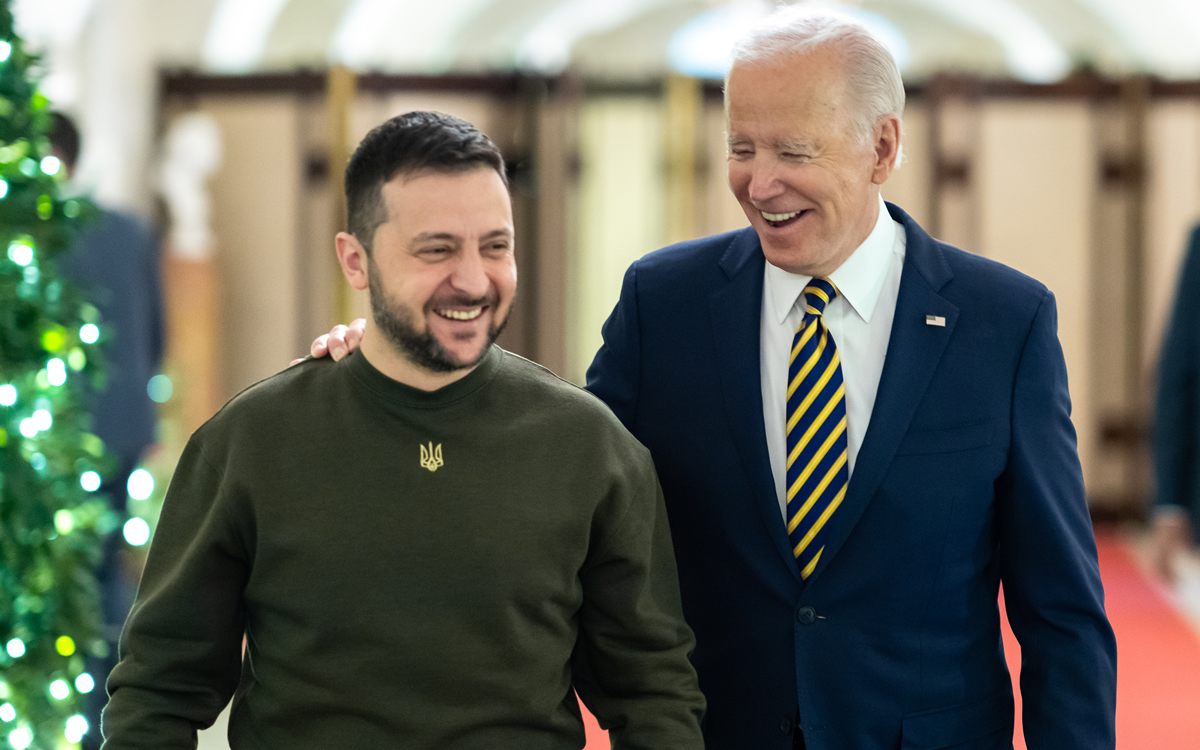
(Official White House photo by Adam Schultz/Twitter)
Zelenskyy over the summer announced he supports civil partnerships for same-sex couples. Ukrainian lawmakers last week unanimously approved a media regulation bill that will ban hate speech and incitement based on sexual orientation and gender identity.
“President Zelenskyy’s response to the civil partnership petition shows his commitment to human rights and the rule of law,” Ashton-Cirillo told the Blade on Wednesday in a WhatsApp message. “He could have avoided answering or hiding behind the ongoing war against the Russian invaders but instead gave a clear response based on dignity and liberty.”
“In Ukraine it is key to remember this is a society that is literally fighting for liberation, for all its citizens,” she said. “The new media law is an extension of that.”
Ashton-Cirillo further stressed that Ukraine “cares about humanity, Putin and his war criminals don’t.”
“The separation between the two societies are clear,” she said. “Life in Ukraine is not about tolerance but about freedom. And now the broader world is beginning to realize this as every new civil rights advance takes place.”
Features
TS Madison Starter House offers a blueprint for Black, trans liberation
When TS Madison cut the ribbon on her Starter House in Atlanta this past Transgender Day of Visibility, she wasn’t just opening a home, she was building a legacy.

When TS Madison cut the ribbon on her Starter House in Atlanta this past Transgender Day of Visibility, she wasn’t just opening a home, she was building a legacy.
Launched on March 31, 2025, the TS Madison Starter House is a re-entry home for formerly incarcerated Black, trans women. The Atlanta-based initiative provides safe, affirming housing for up to five residents at a time who participate in a 90-day program offering job assistance, healthcare, economic opportunities, and holistic support.
Madison shared that the idea grew out of a desire to do more than speak out online. “While getting ready to film The TS Madison Experience season 2, I was talking with my team about what more I could do for my community. I used to feel like everyone else was out marching and being so active, and I was just online talking. But then I started noticing how every time I’d speak out, blogs and media outlets would pick it up… and I realized, wow—I don’t necessarily have to be out in the streets to make change happen. Still, I wanted to do more than just talk.”
That commitment to action led her to turn a personal real estate purchase into a lifeline for her community. “I said, ‘I’m buying a new house… I have this house, can I give the girls housing?’ Because the girls need housing. I remember moving to Atlanta broke and being homeless. I’ve been a house mother—my gay kids have lived with me and thrived. So why not keep doing that? Why not make that intentional?”
The Starter House is powered in part by a partnership with wellness brand Pure for Men and longtime advocacy organization NAESM. As part of its Pride initiatives, Pure for Men donated a portion of June sales to support the house and sponsored attendance for participants at NAESM’s National Leadership Conference on Health Disparities and Social Justice, which took place in Los Angeles from June 25–29.
“We’ve chosen to support the TS Madison Starter House and NAESM because they’re making a real difference in people’s lives,” said Lawrence Johnson, co-founder and CEO of Pure for Men. “With Black trans lives and rights under attack, these organizations are stepping up to amplify their voices, fund essential care and give them the tools to succeed.”
For Madison, the collaboration is rooted in genuine connection. “NAESM is a godsend. It’s a 35-year-old organization with a solid reputation. No scandals. They’re trusted,” she said. “Then there’s Lawrence, the President and CEO of Pure for Men. I had already been using their products before we ever met! We met at a party, just vibing, and it turns out we were already interconnected. We started talking and they shared how they’d been watching me grow and loving my show Phag Talk. And the partnership just blossomed from there.”
The initiative arrives amid rising anti-trans and anti-Black violence, but TS Madison views the Starter House as a political act rooted in love and care. “As a Black,, trans person, I’ve always felt left out by my own Black community. It’s like, once you’re gay or trans, they see you as ‘other.’ Suddenly your Blackness doesn’t count anymore. But I can’t separate the two—I’m Black and trans. I’m both, all the time.”
She added: “When you throw your Black trans child or sibling out, that’s anti-Blackness to me. Because you’re dehumanizing them. My humanity shouldn’t vanish just because I’m trans.”
This work feels both necessary and deeply personal. “I stand on the shoulders of girls who laid down or lost their lives,” Madison said. “And I’m honored to lend my back and shoulders for others to stand on. That’s how we climb—by lifting each other.”
Madison’s message to her younger self is one of strength and perseverance: “I’d tell her: Stay the course. It’s rocky. It’s going to get even more rocky. But stay the course. You are so important, more important than you could ever imagine. Be strong. Don’t be blinded by today. Tomorrow is another day.”
Looking ahead, Madison envisions the Starter House as a model for wider change. “I want it to be the mold for how to give back. Not just one house in Atlanta, but the start of countless starter homes across the nation,” she said. “I want other girls, especially those with privilege or surplus, to see that when you’ve been given so much, it costs nothing to give back. Let this be the example.”
She’s clear on her mission: “This is what I’m supposed to do. And when you’re doing what you’re meant to do, even if there’s opposition, doors will open.”
Watch the full interview:
Features
Koaty & Sumner: Finding love in the adult industry
This Q&A explores the adult content industry and how this couple is making it work for them
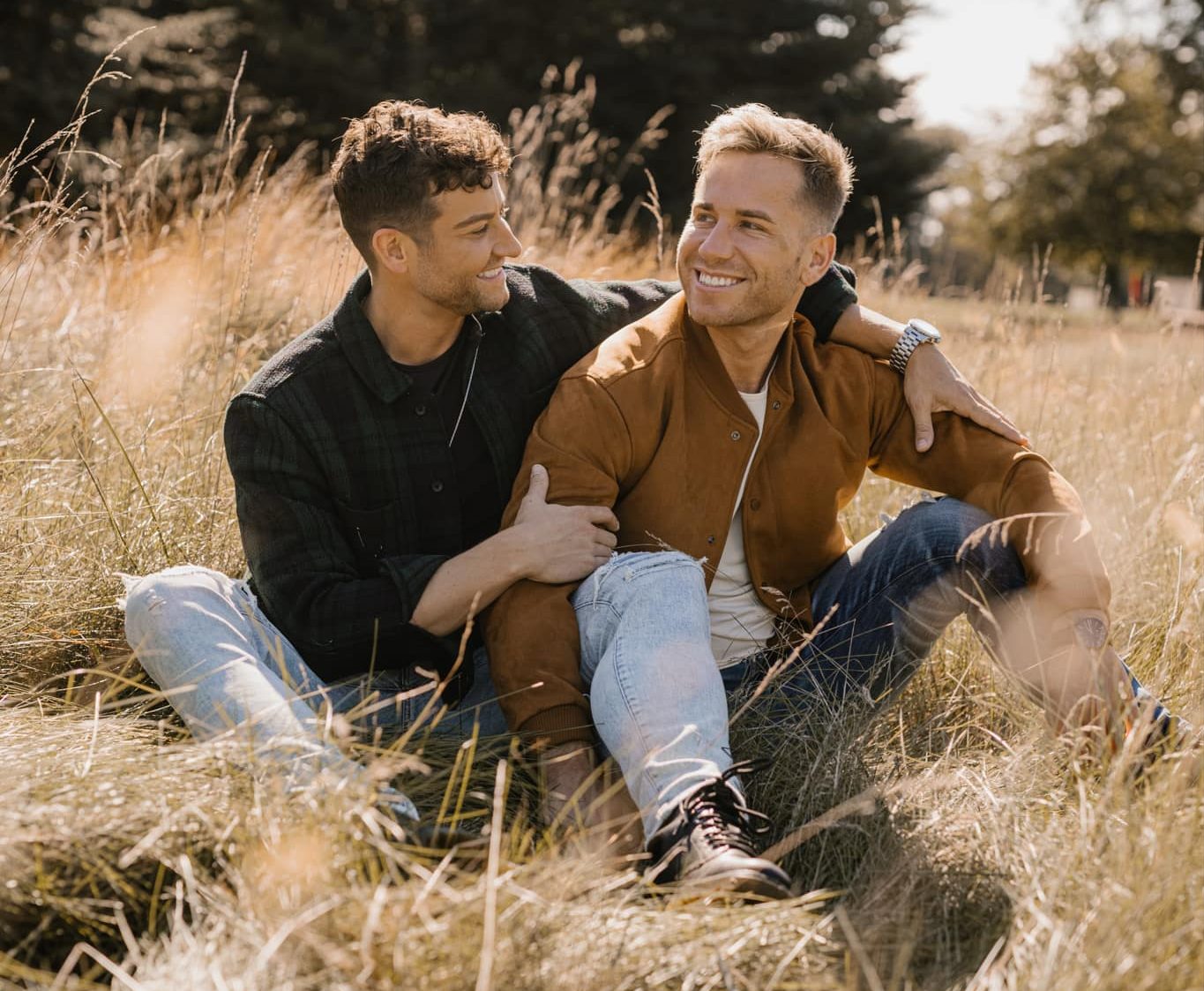
Koaty and Sumner Blayne are not exactly the definition of a conventional relationship. How many couples can say they met during a threesome? It isn’t as lurid as it sounds and it is a sweet story. The couple has been together for six years, got engaged and started planning for a big wedding next year. Whereas most couples clock into work outside of the home, Koaty and Sumner clock in at home, in front of a camera for OnlyFans and social media.
Their lives got national attention as they made their reality TV debut on Tubi’s House of Heat last year, joining other queer and straight OnlyFans content creators in a Hollywood mansion for weeks of filming. The show of course covered the drama of a content creator’s life, including relationship ups and downs, but it also captured the realities of what it takes to be a successful OnlyFans personality. Koaty and Sumner shared the intimate details of their relationship, the exhaustion that comes with the pressure to present the perfect couple day after day and the jealousies that can come with two careers in the adult industry. While Koaty filmed his first adult studio work this year, Sumner has spent a few years working for studio names like Sean Cody, Falcon and Men.com, among others.
Somehow, the two make it work.
The two have become a very popular brand both on OnlyFans and on mainstream social media. It doesn’t hurt that they are constantly coming up with new kinds of content and the fact that they aren’t hard on the eyes at all. This year, they were awarded Best Podcast at the International Content Creator Awards for their debut pod, In Bed with Koaty & Sumner, where they cover all aspects of their lives in the adult industry—the good, the bad, and the challenging.
In this Los Angeles Blade exclusive, we talked to the couple about finding love in the adult industry while keeping the spark alive.
What are some of the biggest misconceptions people have about couples in the adult industry?
People assume we’re either constantly hooking up with others or emotionally detached robots who don’t feel jealousy or connection. In reality, we have boundaries, deep communication and a whole lot of love. We just also happen to have sex on camera. Being in the adult industry doesn’t make us less committed, our job just involves lube.
How do you maintain a healthy relationship—and manage jealousy—in an open relationship?
We’ve had to learn how to have the tough conversations, especially after the honeymoon phase wore off. It’s about recognizing how we each love differently and asking for what we need. Trust and transparency are non-negotiable. We check in constantly—before shoots, after, during dinner—nothing is off limits. We’ve even learned to turn jealousy into compersion. Usually, it just takes a little reassurance… and maybe a snack.
How do you balance your relationship with the pressure of constant content creation?
Sometimes we don’t—and that’s okay. There are days we’re exhausted and need to just be husbands, not performers. We schedule breaks, unplug often, and make time to be us. It’s not always fifty-fifty—sometimes one of us is struggling and the other steps up. We check in, readjust, and give each other grace.
How do you keep the spark alive through the years?
We stay intentional. Too many couples stop talking about sex after the honeymoon phase, expecting it to fix itself. As gay men, we’re often raised without proper sex education and with a lot of shame. We’ve had to unlearn that, be curious and have honest conversations about our needs surrounding sex. The spark stays alive when we keep showing up—and make sex intentional
What have you learned most from each other?
Sumner: Koaty’s taught me patience and how to slow down and feel safe.
Koaty: Sumner’s taught me how to communicate and love without fear.
What do you love most about the other?
Sumner: His loyalty. He shows up for me in ways that make me feel protected and seen—even when I’m chaotic.
Koaty: His vulnerability. He shares his heart so openly. It’s impossible not to fall for him again and again.
How have your families reacted to your careers?
They’ve been super supportive and just want to see us happy—traveling, building a life and doing what we love.
What did you learn about yourselves filming House of Heat?
Reality TV brings out everything—the good, the bad and the unhinged. But it reminded us how grounded we are in each other. Cameras or chaos, what we have is real.
What are some of the biggest challenges you face as a couple in the adult industry?
The constant pressure to perform—on camera, on social media, and emotionally. People project a lot onto us. It’s easy to forget who we are off camera, but we remind ourselves that our relationship comes first—before algorithms, followers, or collabs.
Any sneak peeks for your wedding next year?
We’ve booked the venue! The guest list is coming together… and let’s just say some of our hosts might be from RuPaul’s Drag Race Season 12.
Any advice for other couples in the adult world?
Communicate constantly, keep your ego in check, and treat your relationship like the most valuable thing you have—because it is. The camera should capture your connection, not replace it. Filming can be fun, but it’s still work. Your partnership—the trust, the intimacy, the real love—is what truly matters.
You can follow Koaty and Sumner on Instagram
Check out their podcast, In Bed with Koaty and Sumner
Features
Salina EsTitties and the power of the queer Latinx community
In this Los Angeles Blade exclusive interview, we chat with Salina EsTitties about the strength of the Latinx culture in the face of today’s political oppression and what we must do to remain strong
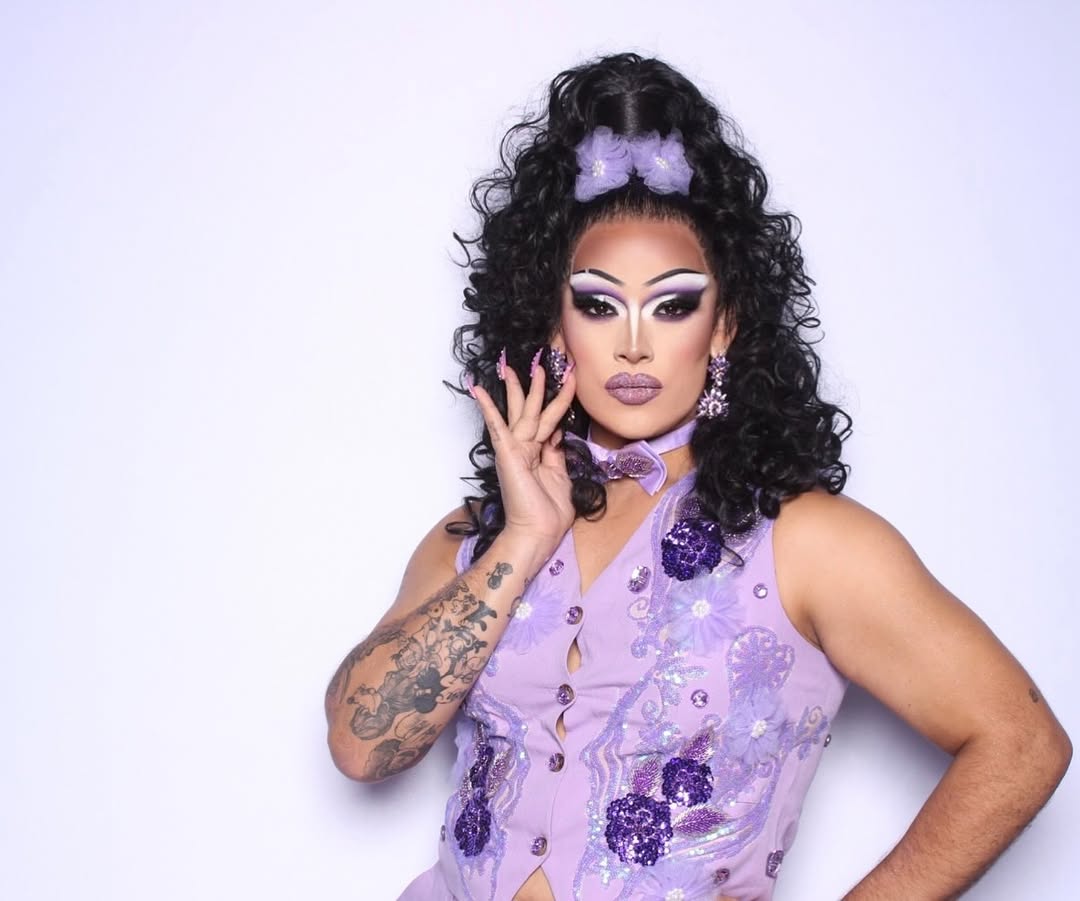
National audiences got to know Salina EsTitties during her run on season 15 of RuPaul’s Drag Race, but Angelenos have been witnesses to the star and activist power that is EsTitties for a decade. She’s not just a fierce entertainer, she’s also a leading voice in the queer, Latinx, drag, and sober communities.
This year, she was announced as the winner of L.A. Blade’s Best Drag Performer at our Best of L.A. Awards. She’s appeared in campaigns for Sephora, Pure for Men, Calvin Klein and more, partnering with numerous non-profit organizations that benefit the queer community and beyond. And yet somehow, she still has time to focus on her lucrative drag and music career.
Even with her continually rising star, she remains humble, down-to-earth and makes time to support events and movements that affect her communities.
This Thursday, she will join the Los Angeles Blade, Latino Media Collaborative and CALÓ News for Diálogo – Pride, Power & Progress, an intimate in-person gathering that brings together powerful voices at the intersection of journalism, identity and social impact.
EsTitties is a fierce believer in the power of the queer Latinx community in Los Angeles and knows firsthand the work that is being done.
“There are leaders in the community that people don’t even realize are out there, going to work for the community, for us as a whole and not just Latinos, but for queer people in general, like trans and trans youth,” she said in an interview with L.A. Blade. “When you go to any function that is a Latino function, there are people who are actually in the streets doing the work.”
EsTitties is all too familiar with the struggles that the organizations she supports are going through, especially as the current administration continues to restrict resources.
“There are people losing jobs who are doing this good work. The leaders of the Latin community are the ones out there in the streets who are actually helping the community,” she continued. “They’re my heroes at the end of the day because it’s those kinds of people who helped me when I was 19, 20 years old, running the streets, homeless, on drugs. They were there for me at those times and their resources provided me with a life that I have today beyond my wildest dreams. I get to twirl around in a wig, you know, but they’re the ones who are out there saving the world.”
EsTitties is also changing the Latinx culture from within. Her presence as a drag queen and a queer (as she puts it) cholo, challenges the machismo norms that are expected of men, changing the narrative of through representation. Her work is a direct result of her early experience.
“It was such a struggle for me in the beginning, especially when I started drag when I was 23. I was so insecure and so hyper-fixated on the masculinity of it all. So I cut my hair off and I quit drag,” said EsTitties, adding that she then landed a job at In-N-Out. “The machismo of it all is something that I grew up with, especially growing up in the hood. I had to acclimate — oversized white tee, baggy blue jeans and Air Force [shoes]. That was the vibe — no color, no queerness, no nothing. I had to present as much as I could to not stand out so I wouldn’t get picked on. Internalized homophobia is very real and toxic masculinity is very real inside of me.”
Eventually, EsTitties did return to drag and it gave her confidence and the voice she now uses to fight for her communities. Over the years, drag taught her how to combine both her masculine and feminine traits in a way that was real for her, embracing her full identity. From her vantage point, she views machismo differently now.
“I’m attracted to masculinity. I don’t think it’s something we have to demonize or villainize, it’s about not making it greater than. I think we’re all equal, I think everyone has all shades of the rainbow, right? I can be feminine, I can be masculine, I can present feminine and still be butch as fuck. It’s all sexy at the end of the day, but I think confidence is where you use it for good as opposed to evil.”
The queer voice in the Latinx community grows stronger every day. Younger generations are gaining the courage to be themselves, not worried about the pressures of conforming. EsTitties says that queer people have always been visible in the community and gives credit to the women of the family — the tias, the mothers, the grandmothers — for showing unconditional love and fostering a vibrant queer community.
As EsTitties prepares to join an impressive panel for Diálogo for a conversation that explores the evolving landscape of Latinx journalism and its vital role in advancing equity, representation and social change, she believes that talk of immigration and the current U.S. Immigration and Customs Enforcement (ICE) raids be at the forefront of any queer, Latinx talk.
“The reality is that I’m sure you know someone, who knows someone who’s undocumented, but there’s a big stigma around that. We’ve heard it from our President that [undocumented immigrants] are rapists, drug dealers. That’s not the truth,” said EsTitties. “My mom came here, undocumented, got her citizenship, then did everything that she needed to do after the fact. And if it wasn’t for my mom doing those things, I wouldn’t be here for it. I am still learning how to navigate it all. This is a conversation that’s very taboo and people just like to pretend it doesn’t exist. But it’s a very real thing that we’re watching in real time.”
EsTitties stressed the importance of the queer community being involved in these conversations because they are issues that affect communities that intersect with other marginalized communities that are particularly vulnerable right now, such as the undocumented immigrant community.
“At the end of the day, we’re human beings. No one should be treated the way that they’re treating human beings right now. Seeing what’s going on right now with ICE is so scary. I know people who are afraid to leave their homes. I have friends who are dyeing their hair a different color every day, so they seem less brown. I have friends who are covering up their tattoos because they think they’re looking for them. People are paranoid and scared right now.”
EsTitties knows that stigma and racism exist even within our own community. That is a reason she works so hard at being visible and active.
“[We need to have a] conversation of just knowing that we Latinos and queer Latinos are not less than our white counterparts. We see white gays running the world, baby. I just hope that I can be one of those people who is like: ‘I’m going to do it regardless of whether you think I can or not, whether you’re rooting for me or not.'”
EsTitties says that in her experience, the queer, Latinx community is often “the butt of the joke a lot of the time.” She says that her communities often have to work ten times harder to get places.
“We’re having to fight a lot of stigma, fight a lot of prejudice, but the thing with Latinos is that we don’t let that weakness show. That confidence and strength, and our passion and our fire, that’s what continues to keep us here and moving. So I think we lean in and continue to be unapologetic, and I think just be a little louder, especially right now.”
Join EsTitties and the Los Angeles Blade for Diálogo, Thursday, June 26th at 6 pm at The Abbey. The event is free; RSVP here.
Features
Resist Without Rage: How this LGBTQ leader is fighting ICE’s terror tactics
‘It’s important to know what our rights are and what ICE can do legally and illegally and when we go places — because we can’t just stay shut in’

Richard Zaldivar, a prominent community leader and founder of The Wall Las Memorias, was pumped and proudly walking hand in hand with his husband Joselito Laudencia, waving to cheering bystanders as The Wall Las Memorias contingent marched down Hollywood Boulevard in the June 8 LA Pride Parade. However, Zaldivar says he noticed that many marchers who signed up, didn’t show. He believes they were terrified that uninhibited militarized masked U.S. Immigration and Customs Enforcement (ICE) agents might sweep them up and disappear them in an unannounced raid just because they are from the Latin American community being targeted by ICE raids.
According to Zaldivar, the terror is real and warranted.
The same day of LGBTQ jubilation, anti-ICE demonstrators swarmed several streets outside the federal detention center in downtown L.A. where ICE held their loved ones. In fact, many of those unidentified detainees arrested Friday and Saturday were surreptitiously hustled into ICE buses, driven to a private charter airline hangar at the Hollywood Burbank Airport, “immediately loaded onto Saab 2000 planes owned by Freight Runners Express / ACE, a cargo and passenger charter airline,” and flown to San Antonio, Texas, according to the Burbank Leader.
Disappearances have become normal in America despite many detainees having legal status or having lived and worked in a community for years, paying taxes, with no criminal record. The usurpation of the constitution right to due process was apparently ordered by White House Deputy Chief of Staff Stephen Miller, who told ICE officials to detain 3,000 migrants a day or be fired.
On Saturday, Donald Trump figuratively poured gallons of fuel on the small protest fire by federalizing 2,000 California National Guard troops, defiantly ignoring the protocol of first being asked for federal help by Gov. Gavin Newsom, LA Mayor Karen Bass or Los Angeles Police Department Chief Jim McDonald, who said the move was made totally unnecessary by activating L.A.’s mutual law enforcement aid agreement with 88 other cities in L.A. County.
By pretending the demonstrations are riots, Trump called up 2,000 additional National Guard troops and 700 Marines, a ruse to invoke the Insurrection Act and gain unchecked power.
I asked Richard Zaldivar to explain what’s happening and offer advice to LGBTQ activists.
“Originally, Mr. Trump had said he was going after the hardcore criminals who were here with no documentation,” said Richard. “We know it’s not happening because innocent people who may be documented and some people who are citizens have been apprehended by ICE and taken into custody.
“I think that is a problem that has been a catalyst for a lot of the protest,” he said. “This cannot happen in the United States of America. This is very scary. It is scary to me and my husband and to the staff and my community…”
“Be focused in on our freedom to be able to protest and share our disgust and anger with those folks [who] deserve that anger. Call that out. But don’t get involved with the anarchists and provocateurs — and they’re here. They’ve been around for many years. They go from city to city and from issue to issue, trying to disrupt the system, the institutions,” said Richard.
“We know that under this administration, everyone is affected,” said Richard. “It’s important to know what our rights are and what ICE can do legally and illegally and when we go places — because we can’t just stay shut in. That’s what this administration wants us to do. They wanna shut us down. Go with friends. Go outside. Take a walk. Walk the dog. Go to the park. Let’s breathe some fresh air and rejuvenate.”
If that’s our intention on a daily basis, we will get through this. If we act collectively, we will get through this as a coalition.
Please go to the LGBTQ+ Freedom Fighters Substack for more reporting and the full 15-minute video conversation with Richard Zaldivar.
Features
How influencer Rose Montoya is using her platform to advocate for trans rights
She’s proving that the fight for trans liberation is personal, powerful and political

Fresh off a double win at the Los Angeles Blade Readers’ Choice Awards for Best Local Influencer and Best Local Activist, Rose Montoya is proving that the fight for trans liberation is personal, powerful, and political. Whether she’s educating millions through her “Trans 101” video series or speaking truth to power in meetings with lawmakers like Alexandria Ocasio-Cortez, Bernie Sanders, Elizabeth Warren, and Pramila Jayapal, Montoya is redefining what it means to be a digital advocate.
“I imagine a world where trans people aren’t just surviving — we’re thriving,” she said. “A future where we have access to community, economic security, and the kind of care every human deserves.” It’s a vision she’s working to build through storytelling, education, and mutual aid. Most recently, Montoya brought that vision to a national stage with a keynote speech at the Human Rights Campaign’s rally for the National Trans Visibility March, held during World Pride in D.C.
She began her public journey in 2014 when she came out as trans, quickly gaining attention on social media for her heartfelt, vulnerable content. One of her early viral moments — a video sermon on LGBTQ inclusion — sparked transformative conversations within her conservative Christian family. “It wasn’t easy,” she recalled. “But over time, with patience and heart-to-hearts, they became some of my biggest allies.”
Since then her platform has exploded. Her “Trans 101” series, often featured in The Blade, breaking down topics like pronouns, gender-affirming care and systemic discrimination into accessible lessons with compassion. A video about discriminatory treatment at airport security led to consulting opportunities with the Transportation Security Administration (TSA). When her TikTok account got banned during a wave of coordinated attacks in 2021, she fought back — writing opinion pieces, launching petitions and assisting over 100 creators with getting access to their accounts reinstated. “When we organize, we win,” she said. “Digital storytelling is more than content — it’s community, resistance, and survival.”
“I’ve faced targeted media attacks, defamation, even threats on my life,” she shared. “It sharpened my resolve. I know how to advocate in hostile environments and I do it for those who can’t.”
Rose’s advocacy doesn’t begin or end on-screen. She’s opened her home to trans youth, facilitated access to housing and healthcare, donated thousands to gender-affirming surgery funds and supports her community through direct mutual aid.
“I know what it means to have your transition made possible through community,” she said. “I wouldn’t be here without the mutual aid I have received.”
That deep sense of purpose is rooted in legacy. “I’m standing on the shoulders of giants — Marsha P. Johnson, Sylvia Rivera, Miss Major, Cecelia Gentili,” she said. “They taught us that advocacy isn’t just about protest. It’s about building something sustainable.”
Still, Montoya noticed a shift in the broader cultural climate.
“There was a time when brands were eager to work with queer creators during Pride Month,” she explained. “Now, many of those same brands have quietly rolled back their DEI efforts. I’ve had partnerships disappear overnight. It’s become clear that, for some, the support was never rooted in real allyship.”
For her, it’s a reminder that advocacy can’t rely on corporate affirmation. It must be community-driven, values-led, and long-term.
As anti-trans legislation continues to spread, Montoya is focused on action. She urges allies to challenge harmful language — even when trans people aren’t in the room. She encourages donations, voting, petitioning and hiring trans people, especially Black, trans individuals. These aren’t symbolic gestures, she says — they’re essential tools in building a world where trans people can thrive. To learn more, visit her website.
When it comes to healthcare, she’s unwavering. “This isn’t just healthcare — it’s life-saving,” she says, pointing to recent cases like Children’s Hospital Los Angeles denying care to patients under 19, despite legal victories overturning similar bans. “Hospitals fear regret liability. But what about the harm of denying care? What about the youth who suffer, or worse, don’t survive?”
For Rose Montoya, advocacy is more than a platform — it’s a love letter to the future. “Our strength is in our solidarity,” she said. “We’re building a world where trans people aren’t just accepted — we’re celebrated.” Thanks to voices like hers, that world is already taking shape.
Written by Prince Joshua, a talented performer known for his high-energy dance, rap and MC skills.
Upon moving to Hollywood, he built a career as a Go-Go dancer and musical
artist, quickly gaining attention with his bold charisma. He has appeared on OUTtv and
performed at major events like WeHo Pride and Phoenix Pride. Prince Joshua was
named GoGo of the Year and Local Artist of the Year in the Los Angeles Blade’s
Readers Choice Awards, recognizing his impact and popularity in the LGBTQ+
entertainment scene.
Arts & Entertainment
Andrew Max Modlin Invites West Hollywood “Through the Brush”
From an iPad in Amerstand to a Canvas in Amsterdam: Modlin Presents “Through the Brush”

It is rare to step into a room where the walls ripple with Icelandic wind, hum with the volcanic heat of Hawaii, and pulse with a wide-eyed color of an Amsterdam trip. This June, West Hollywood becomes a gateway to this world with the arrival of Through the Brush, a pop-up solo exhibit by Los Angeles-based painter Andrew Max Modlin.
The show, curated by renowned critic Peter Frank, opens Saturday, June 7, with an artist’s reception from 4 p.m. to 9 p.m. and runs through June 21 in a studio located at 411 N. La Cienaga Blvd.
Expectations are high — featuring large-scale landscapes, a DJ set, libations and above all, the possibility of escape.
The paintings themselves are immersive 60” x 72” dreamscapes that pull directly from Modlin’s travels to Iceland, Hawaii, Mexico and Amsterdam. They serve as both visual memories and portals to another place in the world, inspired by his travels.
“Traveling is one of the most important things to me because it allows you to see outside your bubble and understand how diverse the world really is,” said Modlin.
He considers the places he visits as extensions of home.
“I immerse myself in what palette the location makes me feel and that immediately comes out in my drawings. It’s bringing that experience back to my studio that makes each painting so diverse because it really has the essence of that location in it.” As the show coincides with Amsterdam’s 750-year anniversary, Modlin says many of the works will be grounded in the city’s distinctive atmosphere.
To understand the intention behind Modlin’s paintings, it helps to understand the artist himself. Modlin is an openly queer artist best known as the co-founder and brand designer behind the cannabis dispensary MedMen and Kreation Organic Juicery. Though successful in business, the pull towards painting never left.
“The fact that I wasn’t painting haunted me all those years because I always felt like that was my life calling,” he said. For a change of pace, Modlin made a drastic change and relocated to Amsterdam. “In that time, I developed how I draw digitally on the iPad.”
That iPad plays an essential role in Modlin’s creative process. His digital sketches are more than rough drafts — they are explosive playgrounds.
“The iPad is where I get to be reckless,” said Modlin. “There’s something precious about a blank canvas but that sense of preciousness doesn’t exist on the iPad.” Without the fear of failure, Modlin can “rapidly sketch with colors that would take much longer to mix by hand,” pushing beyond the limits of traditional materials.
Back in Los Angeles, he focused on translation — how to bridge the digital and physical. “Once I move to the canvas,” explained Modlin. “The process shifts. It becomes more about the physicality of the paint and the act of painting itself than the original composition.”
That act is deliberate and cumulative. “My paintings are a slow, layered process where each brushstroke is a response to the one before it,” said Modlin. “The final piece becomes a record of that dialogue between gesture, surface, and duration.” His works aren’t meant to be consumed all at once — they reveal themselves slowly. Up close, hidden details emerge; from afar, emotions stir. “I hope the viewer starts by getting lost within the painting,” stated Modlin.
Modlin doesn’t see painting as a hobby — it’s a deep expression of self as his work resonates with lived experience. “I’ve always believed in the power of starting things within our own community.” That ethos led Modlin to open MedMen in West Hollywood, making him the first queer dispensary owner in the neighborhood. “With my debut solo exhibition,” said Modlin. “It felt just as important to me that it take place in West Hollywood, the community I live in and care deeply about.”
Through the Brush may feel like a breakthrough, but for Modlin, it’s just the beginning. “For me, success now means seeing my work shown around the world, in spaces that elevate and challenge it.” As Modlin imagines his next chapter, the invitation is clear: “I’d love for that visibility to open the door to working even larger on a scale that allows for something deeply expressive and immersive.”
Features
Tongue pops and truth: Alyssa Edwards on Pride, power and performance
Drag icon Alyssa Edwards talks legacy, love and the magic of living authentically—on and off stage

Alyssa Edwards is a drag icon who needs no introduction — but we’ll do it anyway.
Edwards’ star-studded career accolades span over two decades, earning her a spot on the RuPaul’s Drag Race: Hall of Fame and building an unmistakable legacy on charisma, uniqueness, nerve and undeniable talent.
From the dance studios of Mesquite, Texas, to gracing television screens around the world, Edwards has captivated audiences with her hypnotic wit, larger-than-life persona and unapologetic authenticity. Now, Edwards is bringing all of that and more to the OUTLOUD Music Festival this upcoming Pride month.
In my conversation with this queen among queens, Edwards opens up about the meaning of Pride, the honor of being named the first winner of Drag Race Global All Stars‘ first and what it truly means to live and perform out loud.
Whether she’s coaching young dancers at Beyond Belief Dance Company, laughing over their recollection of awkward first dates, or reflecting on the kinder-queer she once was, Edwards brings heart, honesty and hope to everything she touches. If nothing else, one thing is sure: Edwards is not just part of queer and drag history — she’s writing it.
Let’s get into it.
You’re performing at the OUTLOUD Music Festival. What do you do to prepare and what does it mean to you?
Well, first I wanna start off by saying this is a mega huge honor for me. This is a big year, being the very first Global All Star queen. She’s made it officially into the Hall of Fame. Getting the opportunity to be alongside all of these incredibly iconic performers. I can only say that I’m so honored.
As far as getting — well, right now I’m on tour. So, you know, It’s been a little bit of a juggling act these days. That said, I feel like since I’ve manifested this opportunity, it would only make sense that I bring the Texas size performance that everybody is expecting. This is a huge, huge moment, not only in my career, but also in time. I want to make a statement, I want to be proud, I want to be bold, and I definitely want to be out loud.
And of course [also] wrangling up the dancers and getting the idea of what the choreography is going to be. Right now we’re seeing so many artists come through. I mean, Lady Gaga reminded us this year with “Abracadabra” and its choreography that art is still alive and it is thriving. To me, this takes me back to a time when I would watch MTV and see these videos with this really fierce, synchronized choreography, hand gestures and elaborate costuming. All of this has just inspired me, motivated me and fueled me for this performance. You can expect me to deliver the best of Alyssa Edwards.
You mentioned having been a Global Queen. Did you anticipate returning after season 5 of RPDR:All Stars S2 and then eventually RPDR:Global?
This show really catapulted the Art of Dragon to mainstream television, but we just didn’t know if it was gonna continue on. So when I got the call to go on All Stars 2, four years later, after season 5, I was truly honored. And what a legendary season with a cast of genuine all-stars. After I left the show that year, I was very, very proud of what I presented. You know, something that I teach students over at my dance school, Beyond Belief Dance, is winning isn’t everything but the desire to [win] is. You’ve got to work hard and give it your all.
I didn’t really anticipate all of this. Back then, it just felt like a great opportunity. When Global was announced, with 12 queens from 12 countries and I found out I’d be representing — oh my gosh, good ol’ America — I had to pause. It felt like a huge responsibility. Drag in the U.S., especially through RuPaul’s Drag Race, has become the blueprint for so many franchises worldwide. So yes, I felt the pressure. But I reminded myself, just like I tell my students, show up as the best version of yourself and embrace the moment. Stand proud. Stand proud. Stand proud.
The night of the Global crowning, I stayed home with my partner. No big party, just a quiet moment to reflect. I wanted to honor the 24 years I’ve put into Alyssa Edwards. This wasn’t about validation or vindication. It was a victory lap. A celebration. And sometimes, when you’re having fun and doing what you love… look what comes from it. Now I’m in the Hall of Fame. So take that, and rewind it back.
When you’re preparing for a show like OUTLOUD, how do you plan to connect with your current supporters as well as the folks who might be new to you?
That’s a great question, and one I actually wrote about in my journal while preparing for this. I kept thinking: ‘how can I make this 15 minute performance reflect everything I’ve shared since first stepping onto television 12 years ago?’
I’ve had the chance to travel the world, and I wanted this set to be an accumulation of all those years, all those experiences, all the queerness, artistry and inspiration that shaped me. I wanted to pour it all into this one moment.
For new fans too, like you said, it’s been incredible. [During my last] meet and greet, I saw just how wide the range is. I was recently in Knoxville with my one-woman show, Crowned, and I met everyone from young queens who said: ‘I started watching you when I was 12,’ — which, made me feel a little old but also very proud — to a 70-year-old woman who came with her son and daughter-in-law. She told me she first saw me on Dancing Queen on Netflix, then found my America’s Got Talent performances and finally discovered Drag Race. She had followed my whole journey. She told me: ‘You deserve this. You made us all proud.’
As I walked away, I thought: ‘Wow. I used to be that kid in Mesquite, Texas, waiting on the world to change.’
And now? I’m part of that change. Talk about a plot twist and a trick of fate.
What was it like, kind of giving people a peak behind the curtain for Dancing Queen? What was it like to show people the version of yourself apart from your stage persona?
I mean, I’m not gonna lie, I’m being very candid when I say it was nerve wracking. You know, when you’re having to be unfiltered in every aspect of your life, you know, I am a man that wears many hats. If I am not wearing a wig and performing on stage, I have my teacher’s hat on or my coach’s hat on at the competition.
I have a very full life, and it is very fulfilling in the same aspect, but it is very busy. You’re seeing me in so many different settings and situations, and I really have to give myself credit for being vulnerable. I wasn’t sure I wanted to be that open because, believe it or not, I’m actually a pretty private person.
Looking back, I can laugh now. But at the time? I was embarrassed, just completely socially awkward. I mean, talking about potato salad? It was all kinds of wrong. But sometimes, you have to look back and just giggle. Like: ‘Queen, look at you now.’ Compared to where I was then, I’m in a happy relationship with my partner of four years and love is very much alive in my life. I’m proud of that awkward guy on that date. I’m proud I gave myself grace and permission to be fully, unapologetically me.
I want to go back to the fan of yours who started following your career when they were 12. How would you like to be perceived by the younger generation? What kind of message do you wanna provide them during today’s political climate?
A message of hope. That’s something I can answer quickly, because hope is one of the most powerful things we have. Sometimes it’s all we have. And I truly hope I can be a beacon of light and hope for others.
Growing up, I didn’t see anyone like me on TV. There was no RuPaul’s Drag Race, no Instagram to help me find my people or show me where I belonged. At 18, I had a pager and the Yellow Pages, and that’s how I stumbled across the gay clubs in Dallas. I’ll never forget walking into the cabaret drag room for the first time. It was like falling down the rabbit hole. I was Alice in Wonderland. I saw these bold, unapologetic entertainers, and I was captivated. But deep down, I thought, ‘There’s no way I could ever do that.’
Now, I think about today’s generation, how they can open their phones and instantly connect with their tribe, be inspired, and see themselves reflected in the world. I love that. Because drag gave me a voice. It gave me purpose. And I hope that through my journey, someone else finds theirs.
Whatever you’re going through right now, please, stay tuned. It gets better. At 18 and 19, life was just starting for me. I was shy, I didn’t have many friends, and I wasn’t sure where I fit in. I went to West Mesquite High – home of the Fighting Wranglers – and I mostly kept to myself. But thank God for dance. Those classes were my outlet, my way to express who I was.
I grew up in a home with a southern father who believed boys wore blue and girls wore pink. He valued hyper-masculinity, and there I was, painting my nails with my four sisters, wondering why I couldn’t just be me.
So yes, I’m proud to represent both the past and the present. Proud to be someone who made it through, who found their light, and who now shines it for others. That’s my message of hope: keep going. Your story is just beginning.
How do you celebrate your Pride off the page?
I celebrate Pride all year long. I’m 45, and every time I look in the mirror, I’m proud. I am proud of the man I’ve become, and proud of the storms I’ve weathered. There were times I didn’t have an umbrella. I just danced in the rain. I’m proud to love openly now, something I once felt I had to hide. Back then, I didn’t think the world would understand. But how can it, if we don’t share, teach, and live our truth?
To me, Pride means being fully authentic, transparent, joyful, dancing, singing, even if I’m off-key. It means not hiding anymore. There were years I stayed quiet, only dancing behind closed doors, afraid of what others might think. I didn’t want to make people uncomfortable. But sometimes, growth comes from getting comfortable with being uncomfortable. So yes, I celebrate Pride by living out loud, every single day.
All right. I don’t wanna keep it too long, but one last question, and this is kind of a fun one, but, uh, how does it feel to be honored by Jules and ti um, in season 17 with your iconic back rolls moment?
Oh my gosh, it was hysterical. And look, I didn’t know that was coming up. So I’m sitting at home with my partner and we’re watching it, and I was literally on the floor laughing. I messaged them, and I just was like, Bravo, great job. I think it’s incredible. That’s like the greatest honor, right? It’s like the standing ovation, you know, a good callback.
This was a really fun season and a fun batch of queens to watch on television. I’ll tell you, watching Jules do the makeup on her father really touched me so much. When their dad walks in and is like, Hey queen! That really hit me hard because it just was like, wow! This is the world changing right here. And these queens know who I am. And, once again celebrating pride!
I’m actually a huge fan of Onya Nurve as we’re both Cleveland natives. I’m proud of her. Talk about charisma…
Oh, I messaged Onya! I was like, you are a bright star. Keep shining. The story of Onya Nurve, and then that whole scene with the fathers, it was just like, so, I mean, empowering. It really, really, really touched me deeply. Hearing Onya Nurve share her story and how she can do everything – can sing, can dance, can act, is funny, has a look, knows how to do makeup, do makeovers. It’s like, wow, that’s the power of drag.
This whole group, this whole cast has a special place in my heart. I’m so proud of them. And I’m, I’m proud of myself that I’ve been a part of this legacy and I’m proud of everyone at World of Wonder and RuPaul, who championed this show for years and then got the opportunity to go on Logo 18 years ago. We’re on the 18th season now.
Onya is also in the lineup for the Outloud Festival…
She sure is. And I can’t wait to have the opportunity to kiki with her. I’m gonna get my photo too. I’m gonna have my little fangirl moment. So y’all get ready for that! This is going to be such a fun festival. I mean this lineup. And I just love celebrating every color of the rainbow and all the queerness that is going to be. You know, live loud and lit. We are going to be there. And, just seeing my name on the flyer, I still get a little giddy.
Anything that we should expect from your performance coming up?
You all already know what it’s gonna be. I mean, it’s showtime folks! I’m just truly honored, and I’m grateful that people are still living for the Alyssa Edwards shenanigans. And remember this Pride too. It’s important for us. Visibility is key. I love that this lineup is stacked on stacked. So thank you so much for the opportunity, and I’ll see you all there.
California
New sapphic social club comes to West Hollywood
BBGRL Club debut night brings in full house with Niña Dioz performing live alongside local pop star BBGRL

BBGRL, formerly known as Dom, is an upcoming ethereal pop artist and visionary behind BBGRL Club — the femme-forward collective that aims to celebrate sapphic joy through music, performances and futuristic self-expression. Her pop sound blends synths, intimate vocals and Y2K nostalgia to build a unique experience for her audience.
BBGRL Social Club was born out of the idea that there needs to be more events for lesbians and sapphics in the City of Los Angeles. A city well-known for its vibrant and populous queer and trans community, struggles to make space for the many sapphics that inhibit the metropolis.
West Hollywood is home to a plethora of queer bars that are really open to all, but are locally known to cater more specifically to the gay male community. Whether it’s because of their male go-go dancers, beefy boy bartenders, or open restroom design for urinals and very few stalls, WeHo is very much for the gays.
Now, we’re in 2025 and Dominique ‘Dom’ Buggs, libra, set out to be one of the few sapphics in Los Angeles to make space for the first letter of the acronym. Though there are a few other event spaces that do host consistent sapphic-centered nights, BBGRL, formerly known as Dom, wanted to make sure there was a space that not only welcomed, but centered the BIPOC baddies. Dom is from Mexico City, but is also half Black, so creating spaces like this is her personal mission.
“[The goal] was to make a space where they could belong because I have been living in West Hollywood for many years and I really know there is a huge need for more authentic places that are actually inclusive to people from all walks of life, but that specifically center [sapphic] people,” said Dom in an exclusive interview with the Los Angeles Blade.
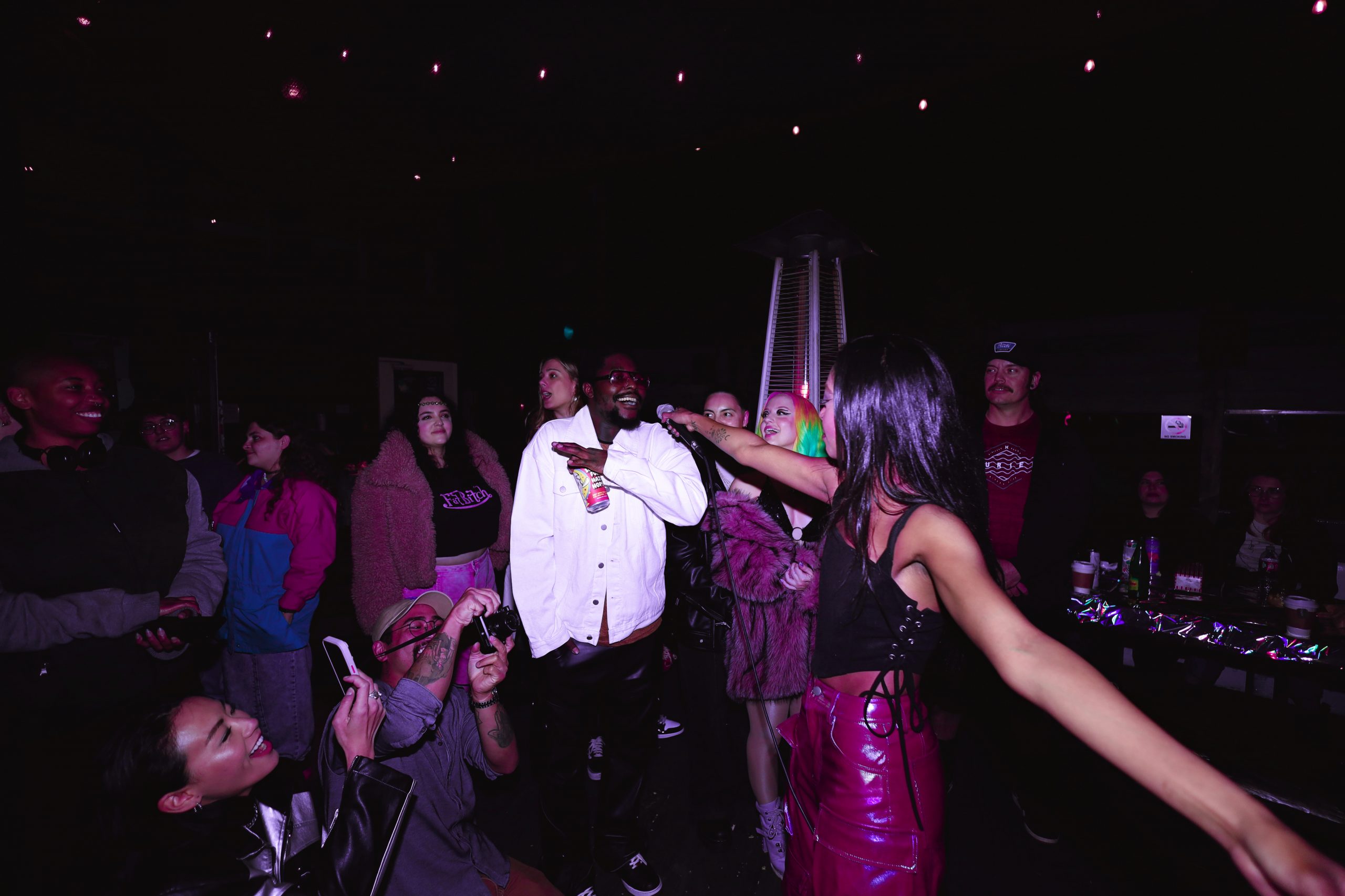
Emerging ethereal pop artist BBGRL interacts with the crowd during her debut night at WeHo’s Roosterfish on May 3, 2025.
(Photo credit to David Tran and Jocelyn Perich)
Even now in 2025 there are very few spaces that consistently cater to the sapphic community. At the start of 2025, there were only two. Only a few months into the new year and The Ruby Fruit — a sapphically-inclined wine bar in Silverlake — closed its doors due to what the owners say were financial circumstances beyond their control. The only other sapphically-centered space is Honey’s at Star Love. The bars opened around the same time, but Honey’s is an eccentric and charming place owned by queer, Black, women.
Though there are very few other spaces that are intentional about making space for lesbian or sapphic nights, there are a lot of event organizers who take up the space on one night of the week or month.
At Little Joy Cocktails in Echo Park, “Butchona” has one day a month to bring in all the lesbianas and butchonas who dress like their tíos — but better. At Bar Flores, there is a “The World is our Oyster” night, whose crowd tends to lean on the sapphic side.
Last December, Roosterfish opened in West Hollywood, now adding itself to the list of brick-and-mortars making has made the space for sapphic events like BBGRL.
“This is my first time performing original music in West Hollywood period — but in a long time too,” said BBGRL. “I’m very excited to share a little bit of what I’ve been working on for some years.”
BBGRL says that spaces like this are very necessary right now because of the social and political attacks on the LGBTQ community.
“I’m really trying to build something that is memorable and something that really brings people together during these times where we really, really need unity.”
During the social event’s debut night at Roosterfish in West Hollywood, BBGRL performed some of her music and invited long-time friend Niña Dioz to perform as well.
“We are comadres and we both realized that we both had so many dreams about moving to L.A. and two years later in 2015 we both made the move and ended up being neighbors in Hollywood,” said BBGRL. “We formed a very special friendship that is really rooted in what reminds us of home — which is our community. Eventually she became my family.”
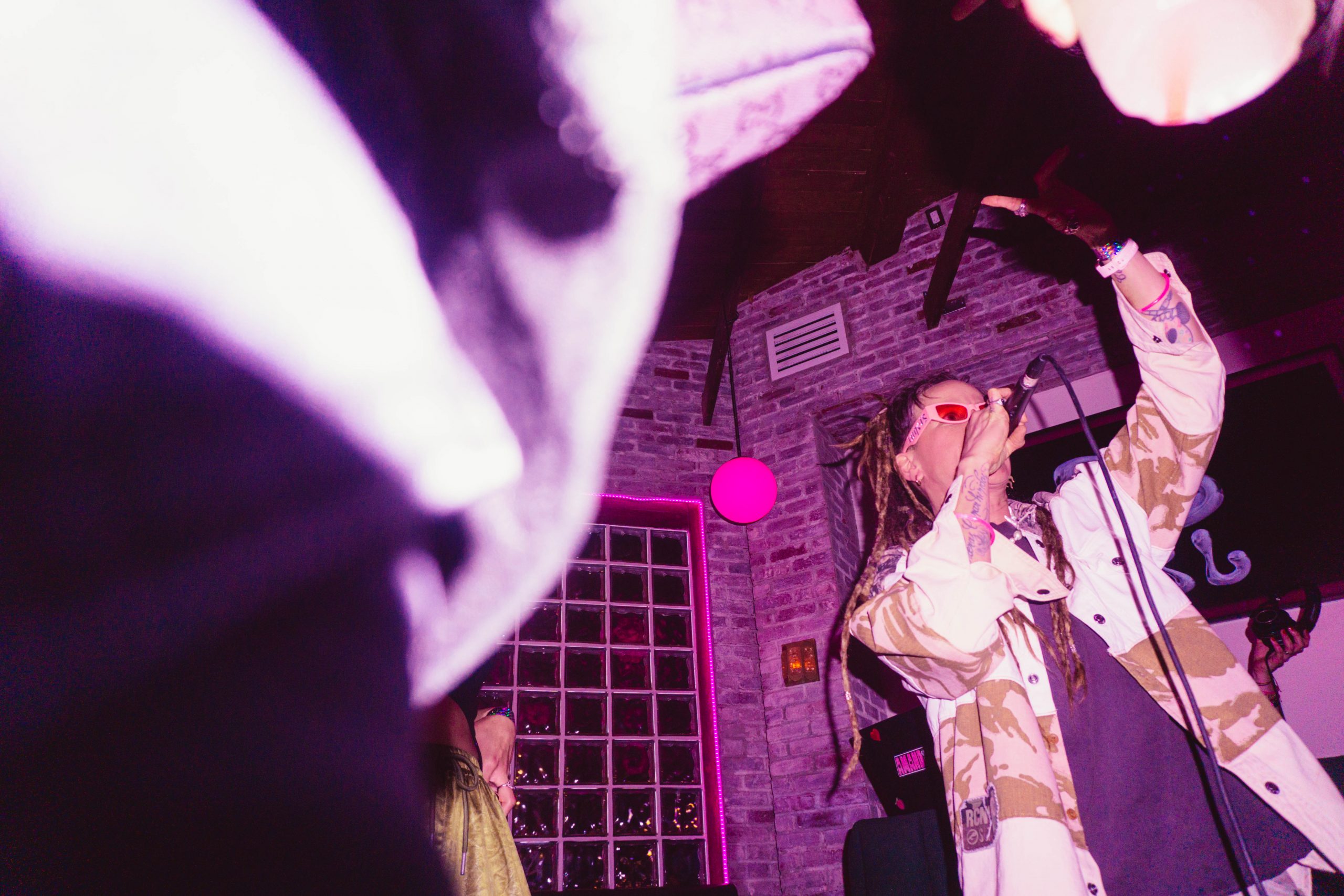
Niña Dioz performs in West Hollywood on May 3, 2025. (Photo credit to David Tran and Jocelyn Perich)
After Niña Dioz returned to living in Mexico, BBGRL says it hit her hard, so their return to Hollywood to perform alongside BBGRL meant that much more to this dynamic duo.
Carla Reyna, better known as Niña Dioz, is a nonbinary, queer hip-hop artist from Monterrey, Mexico. Over a decade ago, they stepped into a rap scene overly-saturated by male rappers within a culture that is also notorious for ignoring and sidelining women, trans and gender nonconforming people. Niña Dioz says they continue to fight the mainstream and make space for themselves and their homegirls.
“I’m super excited to be here performing with my homegirl, BBGRL,” said Niña Dioz in an exclusive interview with the Los Angeles Blade.
Niña Dioz says they are also excited to be working on new music to be released at the end of May.
“I’m just excited to release new music,” said Dioz. “I took a few months off but it’s a song with Lenchanter. She sings chanteos (which is a slang term used in reggaeton music for fast and rhythmic lyrical music) and she is big in the queer, ballroom scene in Mexico City.”
Niña Dioz says they are also excited to be releasing a new house music track right in time for Pride month.
“I’m doing a lot of collaborations with artists from Latin America so you’re definitely going to be hearing from me this year,” they emphasized.
The event will be hosted monthly in West Hollywood and will feature other performers, as well as guest DJs from the sapphic scene. At this event, the line-up included well-known sapphic DJ Amandita, who immaculately brings the vibes at every event where they play their bops but to keep up with the next lineup, follow BBGRL on Instagram.
BBGRL’s next show will be on June 11 at The Peppermint Club in Los Angeles.

Features
Something witchy this way comes with Intuitive Shana
This real-life witch and lifelong mystic is bring the queer aesthetic to SoCal’s paranormal and spiritual world

Though brooms, black hats, and big cauldrons may sometimes play a role in the life of a witch, initiated priestess and lifelong mystic, Intuitive Shana lives the reality of a practicing witch in Southern California’s bustling life, where the paranormal and supernatural are just a moment away.
With the popularity of “Wicked,” the conception of who a witch is and the stigma surrounding the world of magic are changing.
Coming into her powers at a very early age, Shana blends ancient wisdom from her Hawaiian and Italian roots, with modern spiritual tools to dive into the magical world with a deeply personal touch. As much as she is in tune with the realities of Los Angeles life, she is as connected with the other side.
She helps people around the nation on Zoom and in person at The Green Man Store in Burbank connect with their spiritual side. Whether giving workshops, leading rituals, spearheading a ghost hunt, or reading tarot cards — she brings curiosity and reverence to every encounter with the unseen. Shana also hosts two podcasts; Wine, Spirits & Witches and Queer From The Other Side. She’s also often seen roaming around town (even at The Abbey), with her haunted doll, Stephanie.
We’ve hung out with Stephanie, and we can attest — yes, there is something supernatural there.
Shana will be joining our team of writers to give you a monthly rundown, using tarot and a hint of astrology to give us insight on what’s happening in the paranormal and spiritual realms as it relates to queer life in Southern California.
We chatted with Shana as she put the finishing touches on a spell and candle for a client.
How did you first come into contact with the paranormal or other side?
I grew up in a haunted house, so it’s more like the paranormal found me. It was very common to have little things go missing, like a book or a ball of yarn, and then they would show up in odd places like on top of the refrigerator, or on a shelf outside…but only after you asked the spirit in the home to give it back to you. You could look high and low, but if you didn’t ask the spirit for it, good luck!
This was my ancestral home, so the room I grew up in was actually the room that my mother grew up in as well. As far back as I can remember, my grandmother would tell me that there was a portal in my closet and that the ghost of a little boy lived there. Hearing things like that was something that was normal to me, and when you’re a child, you just accept these things as fact, especially if one of your grown-ups is telling you this.
What are the biggest misconceptions about being a real-life witch?
I really think that one of the biggest misconceptions about being a real-life witch is that we are miracle workers. I know a lot of people would think the biggest misconception is that we are all devil worshippers or have sold our souls to Satan, but I actually get that less and less these days! Now it’s, “Oh, you’re a witch? Can you make me famous? Can you curse my ex?” I know the idea of casting spells is appealing because it seems threateningly sexy and makes you think we can solve all of your life’s problems, but that’s not completely the case.
Spells and magic help twist and bend fate into a road that helps lead you in the direction you desire, or at least makes the road more manageable. But you still have to put in work to make things happen. What’s even more important, at least in my eyes, is the fact that witch or not, we are here living the human experience and that’s going to include things like heartbreak and struggle as well as the high points like love and success. We need all of these things to help shape us, magic can’t save you from character development!
How does your queer sensibility add to your intuitive powers?
I really think that my queer sensibility helped me hone in on my intuition and sharpen it from the very beginning. When we are children, we all have an intuitive inclination, but as we grow up, we start to shut it down, attributing a lot of it to imagination and telling ourselves magic, psychic powers, and ghosts aren’t real.
But it takes someone that is willing to reject the norms and challenge themselves to actually lean into and trust themselves and their authenticity to even consider that maybe it’s actually intuition over imagination. Being able to shift my own perspective and look at people, problems, and just the world in general from a queer lens has helped me embrace my intuition as the gift that it is, and become the reader and witch that I am today.
What do you love most about the witch/paranormal community in Los Angeles?
The Los Angeles pagan community is my home. I have found myself in it, grown into who I am, and made my chosen family and coven through it. It’s definitely grown and changed, especially since 2020, but I welcome all the new people into it and am happy to see this community growing and thriving.
While the pagan community and paranormal community can intertwine at times, in my opinion, they are two very different things. Aside from being with a group of ghost lovers, what I really love about the paranormal community is how diverse it really is. There are religious folks, atheists, pagans, and everything in between as far as brief systems. You also get the science geeks dipping their toes into divination tools, and woo-woo people using technology to align and give evidence to their psychic messages. A big melting pot coming together for one spooky reason. As with anything, there may be head-butting at times, but for the most part, people put those differences aside for their love of history and things that go bump in the night.
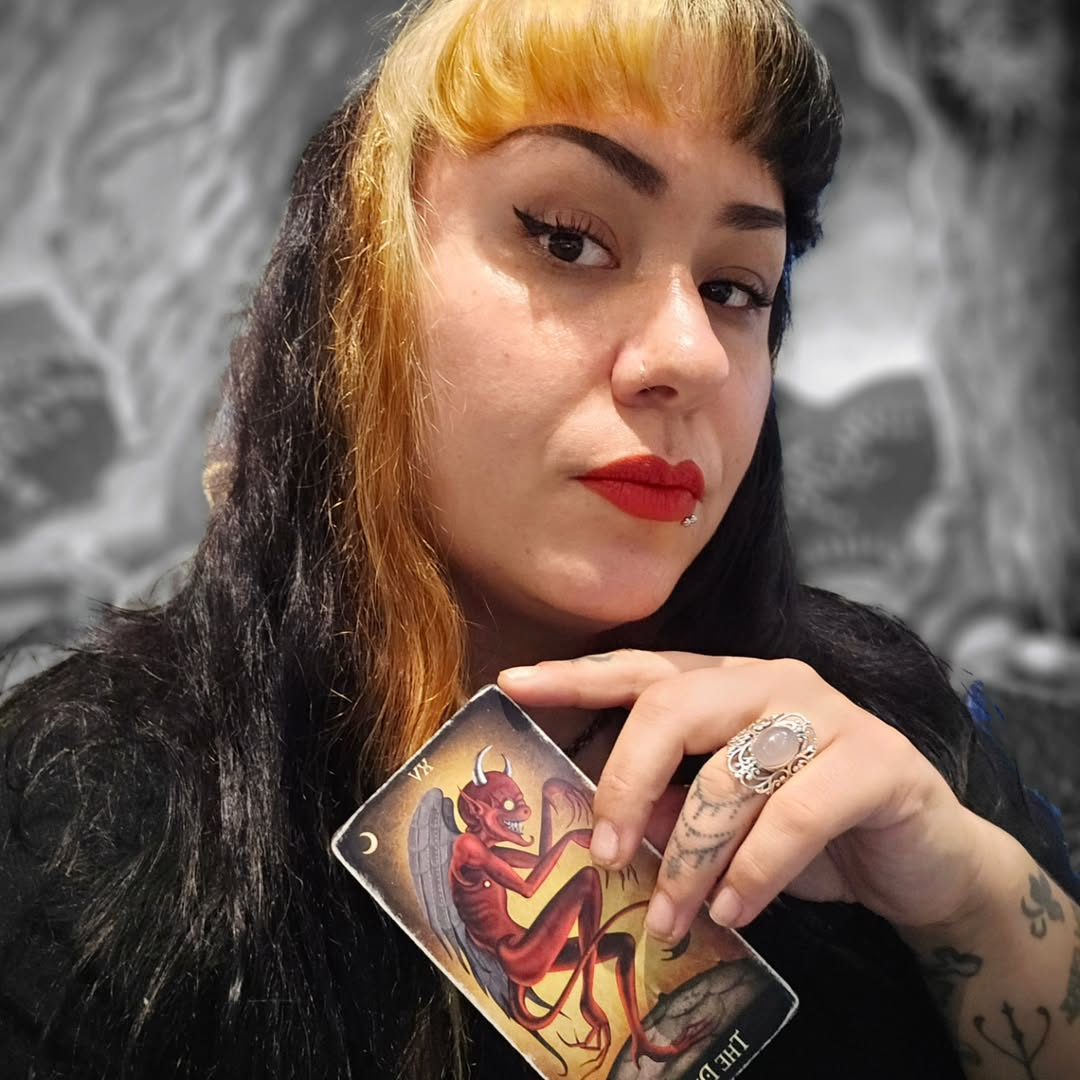
(Photo courtesy of Intuitive Shana)
You have led a series of ghost hunts. What has been one of your best experiences while conducting a ghost hunt?
I’ve been lucky enough to visit some very haunted places and artifacts all around the country, and I have seen and heard some crazy things with my ghost hunting equipment and I have even been a witness to psychic attacks and possession. But even with all of that, there is nothing quite like witnessing paranormal activity with your naked ears and eyes. It’s profound, thrilling, and sometimes terrifying.
The experience that always pops out is an investigation I was on that was closed to the public at an undisclosed women’s prison that is no longer in operation. It checked every box that makes you feel like you are in a horror movie. Peeling paint, sadistic and cryptic messages scrawled on the cell walls… the works. As I was in one of the cells, I heard another cell door not far away banging and banging.
At first, I thought it was a team member being loud, so I went out to snap at him and tell him we couldn’t hear a banshee over the noise he was making. But instead, I found an empty cell block. The banging didn’t stop, and I was able to find the door and set up some lights that would be triggered by vibration and movement.
It turns out that the doors were on an electric system and locked into an open position. The lights were never triggered, but the sound continued. That moment gave me an up-close experience of witnessing a residual haunting through sound. That sound would ring through the cell block every night. A memory staying alive through sound waves.
How can exploring our intuitive side help us in daily life?
Exploring our intuitive side helps us on a lot of levels. It’s kind of like working from the inside out. When you start to trust your intuition, it means that you start to trust yourself in a different and deeper way. This translates to our everyday life because your intuition and, therefore, spirit guides are giving you confidence and validation in your decisions, and that just helps give us an extra slice of peace in regards to the life we are choosing to live.
Being tuned in to what your spirits are saying helps you get a proper read on a person or situation, and we all know that it is always beneficial to be the vibe check queen. Listen to your dreams, your tarot cards, and that primal gut feeling you get. It is never there to steer you wrong.
There is so much turmoil for the queer community right now – politically and socially. How can we get through this tough time spiritually?
The world is a very strange place these days, and we are all feeling the effects of it trickling down and bringing us down as individuals and as a community. This is a time that we can really lean into our spirituality to find inner strength and encourage ourselves to continue doing the inner work to heal and grow. A lot of times, when we do this, it starts as a solo act, and we begin to attract people who are on the same wavelength, and that creates a new sense of community, inspiration, and safety. We must remember that there is strength in numbers.
Now, more than ever, I encourage people to honor and communicate with their ancestors. And when I say ancestors, I am not just talking about blood relatives, even though your mom or grandfather could be an excellent source of power for you. I am talking about past pillars of the community, people who led the revolution, or people who preached love and authenticity and practiced what they preached.
When we honor spirits and give them a space to connect with us, through things like dreams or meditation, they come to us with messages and words, or encouragement. If you don’t believe in spirit communication or think you lack that ability, you can at the very least use this practice to help you shape shift and lean into embodying these archetypes.
Many from the queer community have not had the best relationship with religion. How does being spiritual and connecting with the paranormal differ from being religious?
Religion teaches us to fit inside a box and follow rules. If who you are as a person doesn’t fit nicely into this box, you are shunned, and faced with things like the idea of going to Hell. Spirituality isn’t one size fits all. When I began really studying different belief systems and turning to paganism, the most enticing part of it was the fact that I had the freedom to not only be who I am and be accepted and celebrated for it, but I was also given the freedom to worship and work with any deity that spoke to me.
There was no right or wrong to it. Only what was right for my spirit in that moment. When we are able to look at faith and spirituality as something that is uplifting and blessing us with divine strength instead of something that is condemning us, we open up a whole new world of possibilities that can provide satisfaction to our souls.
You host Queer from the Other Side podcast, who has been one of your favorites guests and what did you learn from them?
We have seen some fascinating guests on Queer from the Other Side! It’s hard to pick a favorite because everyone was so different, but I’d have to say that out of all of the season 1 guests, Nick Brown was my favorite. Nick is an Egyptologist who came on the show and spoke to us about Egypt. It was really informative to hear about his experience as a queer person in Egypt, especially since we all know how controversial and dangerous it can be over there for anyone in the queer community.
I also loved that Nick has a very mundane and grounded point of view when it comes to ancient aliens and Egyptian deities. The conversation stayed informative and nonjudgmental even though we were speaking to him about some of the more “woo woo” theories and beliefs surrounding ancient Egypt.
How do you balance your everyday life and your intuitive life?
Because my 9 to 5 is literally being a witch and spiritual consultant, my everyday life is very blended with my intuitive life. I have learned to create space in my life, both professional and personal, so that my intuition is allowed to flow in and help guide me. Even when its not in big ways like a reading or through ritual, my spirit guides speak up and give me messages or what I call “hits” about things, like when to pay attention to my dog because they are being low key but actually need to go to the vet, or to bring a special piece of equipment with me to work that I normally don’t take with me.
It’s like a fine-tuned gut feeling. I bet if you paid attention, you have it too. Sometimes it’s just subtle.
As with all things, balance is key. Too much freedom to let your intuition and spirit run wild is like drinking too many martinis. It starts out fun, but we both know it’s going to get messy soon enough. Back to the human experience I talked about earlier, we are here on Earth. We have bills to pay, jobs to hold down, and relationships we need to show up for. If you let your spiritual side run the show, these things start to fall apart. So while having a fine-tuned intuition is important to me, it’s equally important that I know when to shut it down and show up as a mundane, regular adult.
You are going to be doing tarot monthly kickoffs for the Los Angeles Blade audience. What will readers walk away with from reading your new column?
I am so excited for the opportunity to start sharing some otherworldly insight with the Los Angeles Blade readers! I’m going to be doing a monthly tarot forecast to help give people a look at the major energies that are going to be sitting with us for the month ahead. This is going to act as a guide to help everyone know when to avoid drama, push harder on their projects, give their love life special attention, or just relax and let life happen. I am going to make sure to note what to expect and how to navigate things if the month has planetary retrogrades (like when Mercury gets spicy and goes into retrograde). And hello, I’m a witch. That means that I will also be dropping bits and pieces of magical knowledge and even suggesting that readers carry a certain crystal or do a particular spell if the month calls for it. Stay tuned, my witchlings!
What is your message to the queer community?
My message for the queer community is to love and honor yourself through both your material life and your spiritual life. Lean on your spirituality, your magic, your spirit guides, and your ancestors.
Follow Intuitive Shana on IG.
Features
Meet your bartender: Matthew Stratman, the muscle of Happy Hour
This familiar face of Motherlode gets the party started early in West Hollywood

Those who frequent Happy Hour at Motherlode in West Hollywood know one of the most familiar faces on Santa Monica Blvd. Matthew Stratman, often showing off his muscled frame in short shorts and a tank top, has been getting the party started early many times a week at this long-time establishment.
Yes, he is known for his good looks (he was a model) and his muscular stature (he’s also a regular at John Reed Fitness), but Stratman’s bartending goes beyond that.
As most bars in West Hollywood are pivoting back to a focus on customer service, Motherlode continues to stand by the ideals of “that neighborhood bar” since its opening in 1979, where staff not only know your drink (often poured before you even sit down), but they also know your name. This is the queer version of Cheers.
It is no big surprise that Stratman was nominated for Best Bartender for this year’s Los Angeles Blade Best of 2025. He continues to pack in a wide variety of clientele every afternoon starting at 3 pm, when Motherlode opens its doors to the very affordable Happy Hour. We do have a word of warning, just like the customer service from yesteryear, they also have a heavy pour, like yesteryear — their drinks are not for the faint of heart.
Stratman’s journey to Los Angeles is a winding one, while coming into his own regarding his sexuality and his career. He has a colorful past that has contributed to his colorful personality. We caught up with Stratman in between his slinging drinks.
You grew up in Missouri, not known for being the most welcoming of queer folk. How did that shape the way you viewed your own sexuality?
While I was in Missouri, it was very difficult because it was not a welcoming place to come out. There was and still is a lot of homophobia, so I knew I had to get out of there and move to a place where I could be myself and live the way I wanted to. In my head, I needed to move to a big city, and I personally wanted somewhere warmer, so LA stood out for me even though I had never been before.
What was your coming out story?
Coming out was the worst experience. I made friends with the only gay person in my town. When people saw this, they immediately thought I was gay. I was still in high school, so this led to bullying. I made a goal for myself to move out of my hometown as soon as I graduated, which I did.
How did coming to Los Angeles and working in nightlife help you be more confident in your sexuality and your identity as a gay man?
I was finally able to be myself and enjoy relationships and friendships in our community. It took a little time to adapt, though. It was such a culture shock to move from a small town to a big city.
Horoscope sign: Sagittarius
Favorite drink you make: Anything fast and easy!
What do you love most about queer nightlife in West Hollywood?
I have met so many people over the years, and it literally feels like one big friendship. At any given time that I walk down the street, I seem to know everyone.
How has nightlife changed the most, for better and for worse, in your opinion?
I think it’s a constant roller coaster. There are always ups and downs. The biggest change I’ve seen is bars coming and going. We have lost some great spots but yet we still have amazing places left. Also, I feel the Pride events used to be more fun when it was affordable for everyone to go. It’s just so expensive now that most people opt out and just go straight to the bars.
Is it true you worked for Bobby Trendy? Do you have any crazy stories from that time?
Yes, I did. I was his assistant for a few years. He was amazing to work for. It was a job that came with a lot of fun, TV time, and weekly parties. I don’t have any crazy stories, but it was fun to meet all the celebrities he did business with.
How many tattoos do you have? 36
What drink do you make the best? Cadillac Margarita
What drink do you secretly hate making? Anything muddled and martinis
What are the biggest misconceptions people have about you as a bartender?
I think the biggest misconception is that people think this is a part-time position and always ask about what my goals are. I love my job and don’t plan on leaving, and they always seem baffled when I say that.
You do double time as a bartender and as a dancer at Motherlode. What aspects do you love the most about doing both?
They are both very different yet the same. Bartending is a lot of work, and so is dancing. Dancing always feels like a break now because I can let my mind be at ease while on the box, because I don’t have any responsibilities while up there, compared to bartending. I talk to so many people at both bartending and dancing. I’m dealing with tip money on both as well. I am lucky to be able to do both jobs at Motherlode, which kind of sets me apart from most others in the bar scene.
Why do you love Motherlode so much?
Bobby! The owner is a treasure! He makes it such a fun place to work. He takes care of all of us and we take care of him. Mark the manager is amazing, and all my co workers Jeremy, Nick, Paul, Doug, Joe, Brandon, Victor, and Michael.
What sets Motherlode apart from other bars in the community?
People just love Motherlode. We are busy all the time at any time of the day or night. We have amazing happy hour specials and a loyal customer base that has made Motherlode their home base. We have amazing DJs, stiff drinks, and no drama. That’s all ya need.
Biggest pet peeve on people tipping you as a go-go?
When they slap your butt with everything they have. Please don’t do this!
What do you do after a long night of working?
I eat everything in sight.
How can the community best support the Weho bar/club scene?
Come out and have a drink. Come out, tip your dancers. Come see and support the drag shows! There is something for everyone.
Guilty pleasure TV show: Criminal Minds
Worst pickup line you’ve heard at the bar? “Why didn’t you come home last night?”
What is your message to the community?
Be nice to everyone! You never know what people are going through. People come out to drink for numerous reasons. I hear a lot of stories, and you can make their day just by simply smiling and acknowledging them.
-

 News2 days ago
News2 days agoWest Hollywood to advance protections for diverse and non-nuclear families
-

 Commentary4 days ago
Commentary4 days agoThe Supreme Court’s ‘Don’t Read Gay’ ruling
-
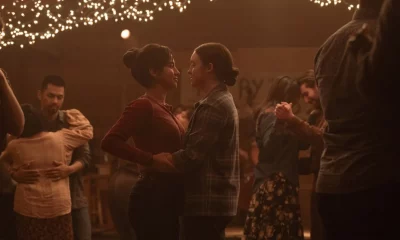
 Arts & Entertainment3 days ago
Arts & Entertainment3 days ago2025 Emmy nominations: ‘Hacks’ and ‘The Last of Us’ bring queer excellence to the table
-
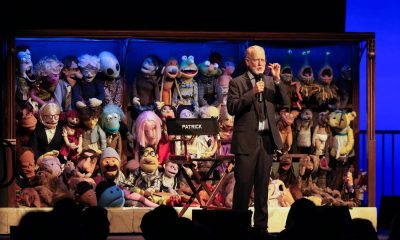
 a&e features4 days ago
a&e features4 days agoThe art of controlled chaos: Patrick Bristow brings the Puppets to life
-

 Movies3 days ago
Movies3 days ago‘Superman’ is here to to save us, despite MAGA backlash
-

 Sports3 days ago
Sports3 days agoHololive and Dodgers create a home for queer fandom
-

 Events2 days ago
Events2 days agoLos Angeles Blade to take special part in NLGJA Los Angeles inaugural journalism awards
-

 Features15 minutes ago
Features15 minutes agoTS Madison Starter House offers a blueprint for Black, trans liberation
